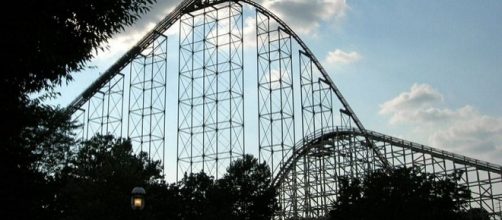Inspired by the notion that the ultimate rollercoaster is a death machine that kills its passengers, a Lithuanian artist (Julijonas Urbonas) created the design in 2010 for a rollercoaster he called Euthanasia Rollercoaster. The rollercoaster allows people to end their lives in a state of euphoria. That said,an expert has questioned Urbonas’ claim that Euthanasia Rollercoaster could spice up the moment of death with "euphoria and pleasure," saying it would more likely make riders sick and nauseated.
The design for Euthanasia Rollercoaster ensures that riders stand no earthly chance of survival.
Yet, the ride promises a lethal dose of g-force that suffocates the brain and delivers a thrill of orgasmic pleasure as death approaches, making the experience of dying more meaningful, according to Urbonas.He designed and built a scale model while he was a doctoral student at the Royal College of Art. The rollercoaster guarantees death by lifting riders to a height of 500 meters, followed by a steep, almost vertical descent, during which the car accelerates to a speed of 100 meters per second, equivalent to 10 g-force.
No human can survive 10 g-force for 60 seconds
The speed reached during the descent from 500 meters provides momentum that takes the car through seven loops,each loop smaller in diameter than the previous.
The design of the seven inversions helps to sustain lethal 10 g-force for 60 seconds and thus eliminates all possibility of survival.
The g-force causes G-LOC (g-force induced loss of consciousness), which leads to death caused by insufficient supply of oxygen to the brain.
"Usually pilots experience such extreme forces for just a few seconds, but riders in the rollercoaster experience it for one minute and nobody has experienced this for such a long time," Urbonas wrote in his blog.
"Your blood is rushed to your lower extremities so there is a lack of blood in your brain. When your brain starts to suffocate, people become euphoric."
The ultimate rollercoaster is a death machine that sends out 24 riders and they all return dead
After the seven inversions, the car stops at a spot where the corpses of riders are offloaded and a new set of riders can be loaded into the cars.Urbonas explained that he was inspired to create a rollercoaster that kills its passengers by a description of the ultimate rollercoaster as one that "sends out 24 people and they all come back dead."He pointed out that the project was primarily an artistic endeavor and that he was not advocating for assisted suicide or euthanasia.
However, he complained that in countries where euthanasia is legal, "It is usually executed in an extremely boring fashion."He argued that the rollercoaster would provide a new approach to euthanasia as "ritualized death." It would help to resolve questions about humane methods for execution of criminals, and could become a useful tool for human population control.
Euthanasia Rollercoaster would likely make you sick
However,Dr. Antonio Damasio, a professor of neuroscience at the University of Southern California, has commented that rather than induce euphoria, the g-force mechanisms of the rollercoaster would more likely make riders sick in their final moment of life.Responding, Urbonas acknowledged that G-LOC could be preceded by nausea and discomfort, but he insisted that the discomfort would be brief and that riders would still experience euphoria. Since Urbonas first exhibited a scale model of his killing machine in 2011 at the Science Gallery in Dublin, no organization has offered to build it.

